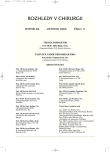Laparoscopic Management of an Infected Oesophageal Cyst
Laparoskopické řešení infikované ezofageální cysty
Ezofageální cysty jsou vzácnou kongenitální anomálií. Nejčastěji se nacházejí v zadním mediastinu kolem distální třetiny jícnu. Ve většině případů je diagnóza stanovena již v dětství jako náhodný nález asymptomatické mediastinální léze. V diagnostice je dominantní CT nebo MRI, ezofagoskopie a endosonografie jícnu. Doporučováno je chirurgické odstranění, protože většina cyst v dospělosti působí potíže tlakem na okolní orgány. V našem sdělení je popsán případ možné komplikace: infikování ezofageální cysty dolní třetiny jícnu po transezofageální punkci. Následkem byl septický stav, který byl řešen laparoskopicky. Přes brániční hiátus byla nalezena cysta v zadním mediastinu, která byla částečně resekována a obsah evakuován. Další průběh byl bez komplikací. Laparoskopický přístup je možný a bezpečný i při infikování ezofageálních cyst. Úplná resekce cysty by byla komplikovaná pro možnost poranění jícnu. Vyzdvižen je význam peroperační ezofagoskopie, kterou je verifikována poloha jícnu při nejasné anatomické situaci v zánětlivém infiltrátu. Je tak sníženo riziko léze stěny jícnu.
Klíčová slova:
ezofageální cysta – aspirace – infekce – laparoskopie – endoskopie
Authors:
V. Procházka
; Z. Kala
; I. Novotný 1; P. Hrobař 2
Authors‘ workplace:
Chirurgická klinika FN Brno-Bohunice, přednosta prof. MUDr. J. Vomela, CSc.
; III. interní gastroenterologická klinika FN Brno-Bohunice
1; Radiodiagnostická klinika FN Brno-Bohunice
2
Published in:
Rozhl. Chir., 2005, roč. 84, č. 11, s. 526-528.
Category:
Monothematic special - Original
Overview
Oesophageal cysts are rare congenital anomalies. Most commonly, they are located in the posterior mediastinum, approximately at the level of the distal third of the oesophagus. In most cases, they are diagnosed during childhood as an accidental finding of a symptomatic mediastinal lesion. ACT or MRI, oesophagoscopy and endosonography of the oesophagus are the essential diagnostic methods. In the adulthood, most of the cysts cause problems pushing against the surrounding organs and, therefore, surgical removal is recommended. In this report, a case of a potential complication is described: infection of the oesophageal cyst of the distal part of the oesophagus following a transoesophageal punction. The case resulted in sepsis, which was managed laparoscopically. Entering through the diaphragmatic hiatus,a cyst in the posterior mediastinum was revealed. The cyst was partially resected and its content evacuated. No complications followed. The laparoscopic method is feasible and safe even if the oesophageal cysts are infected. A complete resection of the cyst would be complicated due to a possibility of injuring the oesophagus. A significance of the peroperative oesophagoscopy to verify the oesophagus position in an unclear anatomic situation due to inflammatory infiltration, is highlighted. The above decreases the risk of the oesophageal wall lesion.
Key words:
oesophageal cyst – aspiration – infection – laparoscopy – endoscopy
Labels
Surgery Orthopaedics Trauma surgeryArticle was published in
Perspectives in Surgery

2005 Issue 11
- Metamizole vs. Tramadol in Postoperative Analgesia
- Metamizole at a Glance and in Practice – Effective Non-Opioid Analgesic for All Ages
- Metamizole in perioperative treatment in children under 14 years – results of a questionnaire survey from practice
Most read in this issue
- Retromuscular Mesh Repair of a Hernia in a Scar According to Rives – Our First Experience
- Small Bowel Perforation as a Late Complication after Laparoscopic Hernioplasty
- Fast Track in Surgery
- Management of Pseudoarthrosis of the Navicular Bone of the Wrist Using the Synthes 3.0
